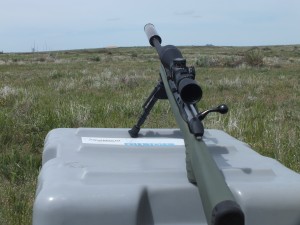 There’s a saying in sports car racing. How fast you go depends on how much you want to spend. The same can be said about firearms. If you want something incredibly fast, or incredibly accurate, you can expect to make a large outlay of cash. Many of us, probably most of us, have limited budgets. In that case, what you really want is the most bang for your buck. You want to stretch your dollar as far as it will go.
There’s a saying in sports car racing. How fast you go depends on how much you want to spend. The same can be said about firearms. If you want something incredibly fast, or incredibly accurate, you can expect to make a large outlay of cash. Many of us, probably most of us, have limited budgets. In that case, what you really want is the most bang for your buck. You want to stretch your dollar as far as it will go.
The purpose of this project was to assemble a package capable of shooting a sub-MOA group at 1,000 yards and get the entire thing done for less than $1,000. This isn’t a new concept. Many others have tried this same goal, and many have failed as well. It’s not necessarily the shooter. Sometimes is equipment, sometimes it’s ammunition, maybe it’s wind, maybe the stars just weren’t lined up right.
Launching a 140 grain projectile with an accuracy of less than 1-MOA over a distance of 1,000 yards is no easy feat. Among accomplished shooters there are only a very few capable of accomplishing such a feat. Any time you’re shooting at distances like this luck is always involved. As a long range shooter my job is to reduce or eliminate variables as much as possible in order to have a good shot. Even with a very accurate wind call and extremely consistent match grade ammunition the rifle/scope combo that we ended up assembling and testing mathematically has only a 70% hit probability at 1,000 yards. That means that on a 1-MOA target we’d miss about 30% of the time due to errors in wind reading or variations in muzzle velocity, among other things.
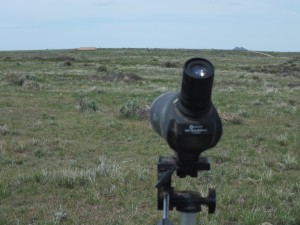
See that mound of dirt waaay out there in the distance? Somewhere in front of that berm is our target.
THE FACTS
After much research, including a couple of hours searching various gun boards on the internet (where the general consensus was that I’m an idiot for even trying this with the components we decided on) we finally determined what parts we could get that, when assembled, would give us the best chance of hitting a sub-MOA group at 1,000 yards for less than $1,000.
Deciding on the scope was the easiest decision. We knew pretty much from the beginning of this project that the Leupold Mark AR Mod 1 in 6-18x40mm would give us the absolute best bang for our buck. Next we had to select a caliber and rifle. At the outset we really liked the 6.5 Creedmoor cartridge from Hornady. It has ballistics that are nearly identical to a .300 WinMag but with less recoil and slightly less wind drift. Then we had a problem. Turns out that it is a bit of a challenge to find an inexpensive yet top-quality rifle chambered in 6.5 Creedmoor that would fit within our budget now that we’d already blown half of it on the scope.
The search took us about a week. We looked at the Weatherby Vanguard and a couple of other rifles including Remingtons and Savages. I would have much preferred to go with a Savage for this build, but the cost when combined with the scope was just too great. We even debated changing the caliber to something more common. The problem with 6.5 Creedmoor is that is still a relative newcomer to the market. There is only one manufacturer and they make only match grade ammunition since it is mostly long range precision shooters that use this chambering. Most of their rifles are custom built, and not cheap, and the factory rifles that come from the show room floor in 6.5 Creedmoor are generally higher end models.
Then we found the Ruger American Predator. It fit perfectly into our budget. Granted, a budget that had been already cut more than in half by the purchase of the scope and rings, but it fit. The Ruger American Predator sports a number of features that we felt would help. Fist off it has a trigger that, while already crisp, is adjustable from 3 pounds up to 5 pounds. It came with a factory installed aluminum one-piece rail. This would help our budget, but I feared might leave us short of elevation adjustment on the scope. The three-lug 70-degree bolt gave us plenty of clearance for the scope, which we didn’t need, but also gave us dual locking cams for increased accuracy. The thing that really caught my eye was Ruger’s trademark Power Bedding. They claim it is an integral system that “positively locates the receiver” but still leaves a fully free floating barrel. They were short on details, but it sounds good so we’ll run with it.
Now, I know you’re thinking it so I’ll lay it out for you. Why spend more money on the scope than the rifle? Why have the scope be literally the most expensive part of this project? The answer is simple. To shoot a 1,000 yards you need to be able to see your target well and to be able to have enough elevation adjustment to dial in your range. You need accurate and repeatable clicks. Yes, the rifle is important. So is the caliber. But with modern manufacturing techniques it is frankly very easy to both get a quality sub-MOA rifle and mass produced match grade ammunition. We needed a scope that was up to the task. In my personal opinion the most common mistake rifle shooters make when going long distances is getting a scope that just isn’t up to the task.
THE TEST
The range we were using is completely private. It’s mostly used by the local law enforcement agencies for training, along with invited guests from time to time. We got there early in the morning when, in an unexpected miracle, the winds were nearly dead calm. I’m not exaggerating when I say that the conditions were perfect.
I had fired the first 4 shots out of the rifle the night before when we sighted it in at 200 yards. Now we set up a little further out at 700 yards. I dialed in the elevation on the Leupold and was immediately on target. 3 more shots confirmed it and we backed up to the 1,000 yard range.
It’s hard to see splash on targets at this distance, even for a trained spotter. The targets we had were a 10-inch disk and a slightly larger square torso-sized target. Both were painted blaze orange. As we set up the target camera to help us spot the groups I fervently hoped that I wouldn’t send a stray round into the not-inexpensive equipment. Just to be safe we set it upwind.
It took 8 more sighting rounds before I was ready to attempt to shoot a group for record. Then, as I added the last couple of clicks of elevation to get perfectly dialed in on that last sighting round the elevation knob stopped. I’d maxed out the elevation just a few inches short of where I wanted to be. Nothing a little holdover wouldn’t fix.
I fired the first round.
“Miss,” my spotter called.
My heart sank as I struggled to get back on to the scope. Then I heard the familiar “thunk” of lead on steel. Wait… it was a hit. Now that I had the target back in my scope I could clearly see the target swinging.
“Sorry, my mistake,” my spotter commented. I still don’t know if he was just messing with me or his bad eyesight just made it that difficult to see a tiny target that far away. With such little wind the mirage appeared to just boil at times, thereby obscuring my view through the Leupold.
The next 2 shots also rang true. We checked the laptop we had linked via Wi-Fi to the Bullseye target camera. There it was, a nice sub-MOA group of three solid hits from a $400 rifle at 1,000 yards.
WE LIKE
The accuracy of the Ruger American Predator was honestly more than I had really hoped for. When we measured and analyzed the group we found that it was just under 0.95 MOA. That’s a very nice group for any rifle at that distance. If you consider that this was a stock rifle with no aftermarket parts and that has had no a work done on the action, barrel, or bedding it becomes in our opinion quite impressive.
We also liked the fact that the Ruger came threaded for a suppressor. Suppressors are popular for long range shooters not just for the sound suppression but also because they usually give a slight increase in accuracy.
The Leupold is impressive in its own right as well. The fact that the adjustments were so dead on that I was able to dial up from 200 to 700-yards and hit the target dead center on the first shot is a testament to the engineering of the scope. Inferior scopes are not nearly as consistent. The glass was also amazing in both the clarity and the the light transmission. This is by far one of the best deals I’ve ever seen Leupold put out on the market.
WE DON’T LIKE
There’s no denying the obvious: The Ruger American Predator is a cheap rifle. The stock simply feels flimsy. The action is not terribly smooth either. Its cold hammer forged barrel is never going to be as good as a custom Krieger, Hart, or Shilen. But then again, those barrels would quickly bust our budget.
Another drawback of the Ruger American Predator is that there is not yet much aftermarket. While we were trying to find a bare-bones basic yet capable rifle, and did so, the lack of upgrade ability hurts the value of this rifle. New shooters or those with limited budgets often get a Remington or Savage, both brands with huge iwc replica followings of loyal fans, because there are so many upgrade options available. When their budget allows later they can, one piece at a time, build their budget rifle into a much nicer and better performing one.
The final thing that somewhat unpleasantly surprised us was the ammunition. While chronographing Hornady’s match grade ammo we also noticed a few periodic spikes in muzzle velocity. Some rounds inexplicibly jumped from the 2745 to 2755 range up to nearly 2800. For rounds intended for use in long range precision competitions this could be the difference between a X-ring hit or having a flyer up in the 8-ring. We contacted Hornady about our concerns.
They replied “Checking the load data for that lot number shows the ammunition ran almost exactly at 2700 fps with a standard deviation of about 8 fps. Your altitude will make some difference but if you are shooting a rifle with a significantly tighter chamber and bore then you will have higher pressures and it can result in increased velocity which may be causing your bullet to yaw slightly.”
It’s possible that it was the rifle I suppose, but I found it a bit implausible that bullet yaw that severe would be able to add 50 feet per second off when the chronograph was only 10-feet away, and still give us the sub-MOA accuracy we had out at the range test. Nevertheless, the performance was adequate for our needs that day, and most serious rifle competitors run hand loads anyway.
THE VERDICT
The Ruger American Predator shocked us all. It’s not an expensive rifle, and it doesn’t feel like it either, but it has it where it counts. It was soon obvious to us that Ruger cut every corner they possibly could to get the cost of this rifle down but left the important quality components intact. The trigger isn’t a Timney or a Jewell, but it is remarkably crisp with very little take-up. It’s also user-adjustable so that you can fine tune it to your likes.
The Leupold is quite frankly an amazing scope, and we knew that from the outset. It’s no Nightforce, and at only 18x magnification it is starting to stretch out at 1,000 yards. The glass offers stunning clarity however and it wasn’t difficult to see the target. By essentially building around the scope we were able to meet our goal.
ACCESSORIES
Okay, okay, we cheated. But only a little, I swear! In order to maximize our odds of success we used a few accessories that were not included in the build cost. Only two of them were what most people would consider performance enhancing: a bipod and a suppressor.
Harris Bipod – This was personally owned by myself but you can find them online for around $74.99.
.30 Caliber Suppressor – This can was hand built by the landowner of the range we used. You can build one like it yourself using parts from SD Tactical if you pay the NFA tax and get a stamp on your Form 1 after you send it to the ATF, but check your local laws first. Some states still ban suppressors.
Bullseye Camera System – Seeing the hits on the target, even with the land owner on a high-power spotting scope, is incredibly difficult. With a transmit range of over a mile, we were able to view the hits on my laptop stationed at our shooting position. You can buy these online at http://www.bullseyecamera.com/ for $549.00
The Build Sheet
Ruger American Predator in 6.5 Creedmoor – We found this online at GunBroker.com and won the auction at $370.00 plus $25.00 shipping to my FFL.
Leupold Mark AR MOD 1 Rifle 6-18x40mm 1/10 Mil Adjustments – This was acquired from Midway USA for $549.99 and was the most expensive component. Shipping was free.
Vortex Viper Picatinny-Style Rings Matte – Vortex makes high quality rings, and at only $54.99 these fit nicely in our budget. These were also from Midway USA, and had free shipping.
Ruger American Predator (with shipping): $395.00
Leupold Mark AR 6-18×40 Scope: $549.99
Vortex Rings: $54.99
TOTAL COST: $999.98
Ruger American Predator Specs
Stock: Moss Green Composite
Capacity: 4
Barrel: Cold Hammer Forged
Barrel Length: 22-inches
Twist: 1:8 RH
Grooves: 6
Overall Length: 42-inches
Thread Pattern: 5/8-24
Weight: 6.6 lbs.
Length of Pull: 13.75-inches
Suggested Retail: $499.00
Street Price: $300.00 – $400.00
Ballistics of the 6.5 Creedmoor
We had one distinct advantage during the testing of this rifle that was not related to the rifle, the scope, or any of the other components or accessories.
The area we were conducting the test was at an altitude of over 4,300 feet. Long range precision rifle shooters are well familiar with the fact that ballistics change dramatically at different altitudes. The chronograph revealed during our testing that the 6.5 Creedmoor at this altitude, and using a suppressor, reached a muzzle velocity of between 2750 and 2800, with 2755 being the mean value.
Using JBM Ballistics We get the following data:
| Calculated Table | ||||||||||
| Range | Drop | Drop | Windage | Windage | Velocity | Mach | Energy | Time | Lead | Lead |
|---|---|---|---|---|---|---|---|---|---|---|
| (yd) | (in) | (MOA) | (in) | (MOA) | (ft/s) | (none) | (ft•lbs) | (s) | (in) | (MOA) |
| 0 | -1.5 | *** | 0.0 | *** | 2759.5 | 2.441 | 2366.8 | 0.000 | 0.0 | *** |
| 100 | 29.7 | 28.4 | 0.1 | 0.1 | 2625.3 | 2.323 | 2142.1 | 0.111 | 0.0 | 0.0 |
| 200 | 55.9 | 26.7 | 0.2 | 0.1 | 2494.9 | 2.207 | 1934.6 | 0.229 | 0.0 | 0.0 |
| 300 | 76.5 | 24.4 | 0.5 | 0.2 | 2368.2 | 2.095 | 1743.2 | 0.352 | 0.0 | 0.0 |
| 400 | 90.9 | 21.7 | 1.0 | 0.2 | 2245.2 | 1.986 | 1566.7 | 0.482 | 0.0 | 0.0 |
| 500 | 98.4 | 18.8 | 1.5 | 0.3 | 2125.7 | 1.881 | 1404.5 | 0.620 | 0.0 | 0.0 |
| 600 | 98.2 | 15.6 | 2.2 | 0.4 | 2010.0 | 1.778 | 1255.8 | 0.765 | 0.0 | 0.0 |
| 700 | 89.3 | 12.2 | 3.1 | 0.4 | 1898.3 | 1.679 | 1120.0 | 0.918 | 0.0 | 0.0 |
| 800 | 70.9 | 8.5 | 4.2 | 0.5 | 1790.7 | 1.584 | 996.6 | 1.081 | 0.0 | 0.0 |
| 900 | 41.5 | 4.4 | 5.5 | 0.6 | 1687.6 | 1.493 | 885.2 | 1.254 | 0.0 | 0.0 |
| 1000 | -0.0 | -0.0 | 7.1 | 0.7 | 1589.6 | 1.406 | 785.3 | 1.437 | 0.0 | 0.0 |
| 1100 | -55.3 | -4.8 | 9.0 | 0.8 | 1497.0 | 1.324 | 696.5 | 1.631 | 0.0 | 0.0 |
| 1200 | -126.2 | -10.0 | 11.2 | 0.9 | 1410.6 | 1.248 | 618.4 | 1.838 | 0.0 | 0.0 |
Compared to the same round at a factory advertised muzzle velocity of 2700 FPS at sea level.
| Calculated Table | ||||||||||
| Range | Drop | Drop | Windage | Windage | Velocity | Mach | Energy | Time | Lead | Lead |
|---|---|---|---|---|---|---|---|---|---|---|
| (yd) | (in) | (MOA) | (in) | (MOA) | (ft/s) | (none) | (ft•lbs) | (s) | (in) | (MOA) |
| 0 | -1.5 | *** | 0.0 | *** | 2705.3 | 2.393 | 2274.6 | 0.000 | 0.0 | *** |
| 100 | 34.0 | 32.4 | 0.1 | 0.1 | 2550.3 | 2.256 | 2021.5 | 0.114 | 0.0 | 0.0 |
| 200 | 64.1 | 30.6 | 0.3 | 0.1 | 2400.5 | 2.124 | 1791.0 | 0.235 | 0.0 | 0.0 |
| 300 | 88.1 | 28.1 | 0.6 | 0.2 | 2255.7 | 1.996 | 1581.5 | 0.364 | 0.0 | 0.0 |
| 400 | 105.4 | 25.2 | 1.0 | 0.2 | 2115.8 | 1.872 | 1391.4 | 0.502 | 0.0 | 0.0 |
| 500 | 114.8 | 21.9 | 1.7 | 0.3 | 1981.1 | 1.753 | 1219.9 | 0.648 | 0.0 | 0.0 |
| 600 | 115.4 | 18.4 | 2.5 | 0.4 | 1851.9 | 1.638 | 1065.9 | 0.805 | 0.0 | 0.0 |
| 700 | 105.8 | 14.4 | 3.5 | 0.5 | 1728.5 | 1.529 | 928.6 | 0.973 | 0.0 | 0.0 |
| 800 | 84.6 | 10.1 | 4.7 | 0.6 | 1611.8 | 1.426 | 807.4 | 1.152 | 0.0 | 0.0 |
| 900 | 50.0 | 5.3 | 6.3 | 0.7 | 1502.4 | 1.329 | 701.6 | 1.345 | 0.0 | 0.0 |
| 1000 | -0.0 | -0.0 | 8.2 | 0.8 | 1401.3 | 1.240 | 610.4 | 1.552 | 0.0 | 0.0 |
| 1100 | -67.8 | -5.9 | 10.4 | 0.9 | 1309.8 | 1.159 | 533.2 | 1.774 | 0.0 | 0.0 |
| 1200 | -155.8 | -12.4 | 13.1 | 1.0 | 1228.8 | 1.087 | 469.3 | 2.010 | 0.0 | 0.0 |
Buy This Rifle
Now, I know what you’re thinking: “You fancy gun writers probably got all this stuff for free, or at least at-cost or at a discount, and there’s no way we could build the same thing for this price.”
Not so fast. To prove our point we’re going to be selling this exact build online at GunBroker.com in an auction that will begin on October 1st. Proceeds from the auction will be donated to HAVA (Honored American Veterans Afield – https://www.honoredveterans.org/) a favorite charity of Ruger.


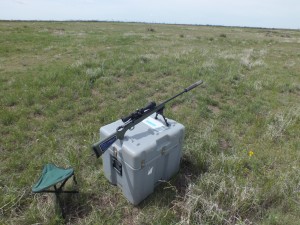
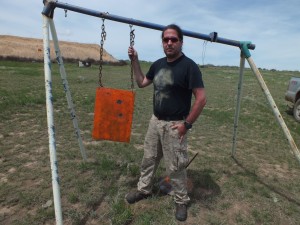
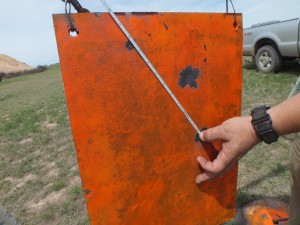
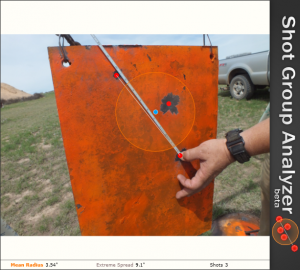

Nice report. And as you’ve said, one gets what one pays for. Anything over three rounds, and that barrel is going to overheat and start waving, throwing rounds all over the place. But, for up to three rounds, it will perform accurately.
[…] Shoot 1,000 yards for $1,000 […]